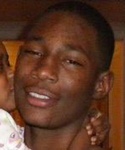By Kevin Casey, Cathaleen Chen, Dani Chung and Katherine Prentiss
Special to Homicide Watch Chicago
Every weekday morning, 16-year-old Antonio Fenner would carefully knot the tie on his Junior ROTC uniform. He’d just learned how to do it correctly, his mother remembered with pride.
But Saturdays, he was out of uniform. Saturdays, he played with his brothers and sisters, 8, 7, 5, and 4. Saturdays, he visited family and hung around the neighborhood park.
January 26 was a Saturday. And it was like any other for Fenner, until he was shot and killed. They found his body at 4 p.m. on the sidewalk next to a vacant lot in West Garfield Park, about a mile from his home.
Antonio Fenner was a freshman at Manley Career Academy who liked to play sports — football, basketball, “any type of sport,” said his mother, Marshall Langston. She recalled that he woke up the last day of his life and played with his younger brothers and sisters. They were a household of seven — Antonio, Langston, the siblings and their stepfather, Clarence Sheen.
After the family left to go to a birthday event for the afternoon, Antonio went to visit other relatives who live near their apartment in the 4400 block of West 15th Street. At 4 p.m., shortly after she and her son went their separate ways, Langston received a phone call that he had been shot and killed. He was the 37th homicide victim in Chicago that month.
“How is it you could just see a person one minute and they’re gone the next?” Langston said. “He was just getting to know life. For a person to just take his for no apparent reason, that’s not right.”
She believes Fenner was in the wrong place at the wrong time. His body was found on the sidewalk at the 4200 block of West Congress Parkway, next to that of Dimitri Buford, 32.
There have been no arrests and there are no suspects in the shootings, according to the Chicago Police Department. Langston said no one in Fenner’s family knows Buford, and it’s unclear what Fenner’s association with him was.
Buford was affiliated with the Traveling Vice Lords, according to a Chicago Police Department report on the shootings. Records show he had an extensive criminal record that included convictions on drug charges and for sexual assault.
Fenner’s school principal describes him as vibrant and charismatic. “I would never classify him as an angel, nor would I classify him as a deviant,” said Warren Morgan II, principal of Manley Career Academy. “I think he was still finding his way as a lot of our high school young men are.”
Morgan, who spoke at Fenner’s funeral, said that Fenner’s penchant for socializing was both a “blessing and a curse,” a charming trait that also got him in trouble for talking during class.
“[He was] a presence that both his teachers and his students could resonate with and were really attracted to,” Morgan said.
At the end of his first high school semester, Fenner was failing his classes and not coming to school, Morgan said. But with help from the Manley administration and a community program, he improved. He joined the Junior ROTC, and by the time of his death, he was passing all of his classes, the principal said.
“He had been working very hard,” Morgan said.
Fenner, a slight figure at 5’3” and 145 pounds, was never shy to come to school dressed in his uniform. He wore his hair in dreadlocks and socialized in the hallways of Manley, a school of about 700, where more than 85 percent of students come from low-income households.
Warren said Fenner’s death profoundly affected his freshman classmates. They made a mural in the hallway to commemorate him, and for about a month afterward, their disciplinary infractions and attendance fluctuated drastically.
“After Antonio died…we saw a range of emotions. We saw everything from [students] being very energetic and not being able to focus to being very angry. They were getting very angry at each other,” Morgan said. “When we look at it as school-wide data, we call it the ‘Antonio Effect’.”
Manley had lost another student to gun violence the previous school year. Jeffrey Triplett, 17, was shot to death on May 26, 2012.
Fenner’s death came amid heightened national attention toward gun violence. Less than two months earlier, 26 students, teachers and administrators were shot to death at Sandy Hook Elementary School in Connecticut. Three days after Fenner’s death, the shooting death of another Chicago high school student, Hadiya Pendleton, shifted the focus of the national dialogue about gun violence to Chicago.
By July 1, 2013, Chicago homicide toll had risen up to 187, almost all of which involved guns.
More than 40 percent of households in West Garfield Park are below the poverty level. In the first five months of 2013, there have been 175 violent crimes in the neighborhood. According to a Chicago Tribune crime index that compares 77 neighborhoods, West Garfield Park has the fifth-highest number of reported crimes in April and May of this year.
“It’s a mess,” Langston said. “If we make more impact on being role models and everything, these young kids nowadays wouldn’t be coming up the way they coming up, disrespectful and [such]. They shouldn’t have to turn to guns to get their point across.”
(This story was produced for Homicide Watch Chicago by students in the “Chicago, Journalism and Social Change” class at the Medill School of Journalism at Northwestern University. Funding for the reporting was provided, in part, by the Alumnae of Northwestern University’s Gifts and Grants Committee.)






